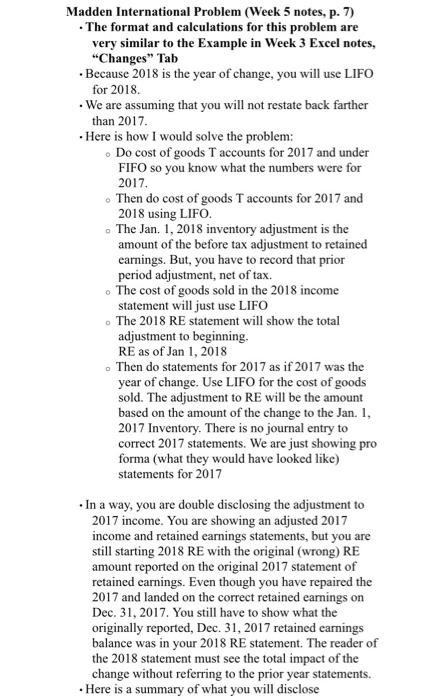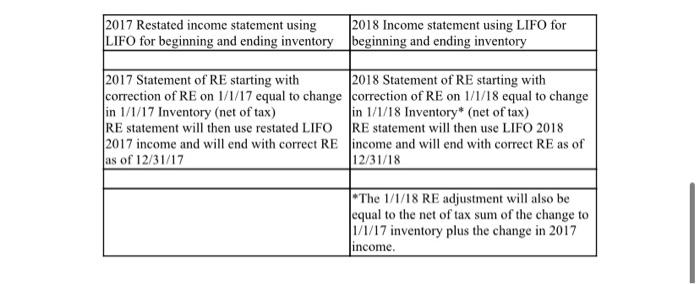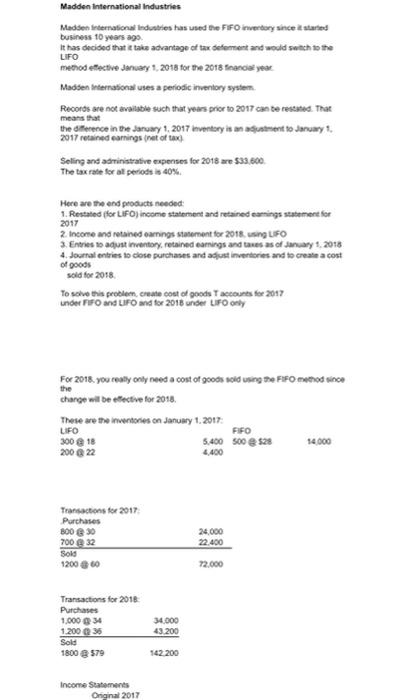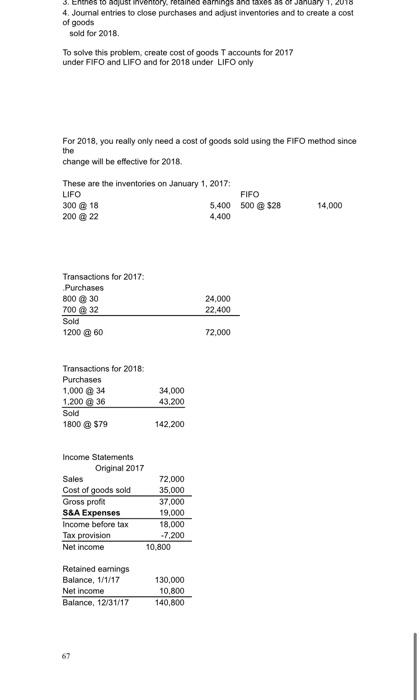Madden International Problem (Week 5 notes, p. 7) . The format and calculations for this problem are very similar to the Example in Week 3 Excel notes, "Changes" Tab Because 2018 is the year of change, you will use LIFO for 2018. We are assuming that you will not restate back farther than 2017. Here is how I would solve the problem: . Do cost of goods T accounts for 2017 and under FIFO so you know what the numbers were for 2017. . Then do cost of goods T accounts for 2017 and 2018 using LIFO. . The Jan. 1, 2018 inventory adjustment is the amount of the before tax adjustment to retained earnings. But, you have to record that prior period adjustment, net of tax. The cost of goods sold in the 2018 income statement will just use LIFO . The 2018 RE statement will show the total adjustment to beginning, RE as of Jan 1, 2018 . Then do statements for 2017 as if 2017 was the year of change. Use LIFO for the cost of goods sold. The adjustment to RE will be the amount based on the amount of the change to the Jan. 1, 2017 Inventory. There is no journal entry to correct 2017 statements. We are just showing pro forma (what they would have looked like) statements for 2017 . In a way, you are double disclosing the adjustment to 2017 income. You are showing an adjusted 2017 income and retained earnings statements, but you are still starting 2018 RE with the original (wrong) RE amount reported on the original 2017 statement of retained earnings. Even though you have repaired the 2017 and landed on the correct retained earnings on Dec 31, 2017. You still have to show what the originally reported, Dec. 31, 2017 retained earnings balance was in your 2018 RE statement. The reader of the 2018 statement must see the total impact of the change without referring to the prior year statements. Here is a summary of what you will disclose 2017 Restated income statement using 2018 Income statement using LIFO for LIFO for beginning and ending inventory beginning and ending inventory 2017 Statement of RE starting with 2018 Statement of RE starting with correction of RE on 1/1/17 equal to change correction of RE on 1/1/18 equal to change in 1/1/17 Inventory (net of tax) in 1/1/18 Inventory* (net of tax) RE statement will then use restated LIFO RE statement will then use LIFO 2018 2017 income and will end with correct RE income and will end with correct RE as of as of 12/31/17 12/31/18 *The 1/1/18 RE adjustment will also be equal to the net of tax sum of the change to 1/1/17 inventory plus the change in 2017 income. Madden International Industries Madsen International Industries has used the FIFO eventory since 2 started It has decided that e take advantage of tax deferent and wood sunch to the method effective January 1, 2018 for the 2018 francis year Massen International uses a periodic inventory system Records are not available such that years prior to 2017 can be recitedThat the difference in the army 1, 2017 inventory is an adjustment to Jarwy 2017 retained earningsnet of tax) Selling and administrative expenses for 2018 we$33.600 The tax rate for a periods is 40% Here are the end products needed 1. Restate (for LIFO) income statement and retained earings statement for 2017 2.Income and retained earnings statement for 2018 using LIFO 3. Entries to aqust inventory, retained earnings and takes as of January 1, 2018 4. Journal entries to close purchases and adjust inventories and to create a cost of goods sold for 2018 To solve this problem, create cost of goods accounts for 2017 under FIFO and LIFO and for 2016 under UFO only For 2018. you really only need a cost of goods sold using the FIFO method since change will be effective for 2018, These are the inventories on January 1, 2017: LIFO FIFO 300 @18 5.400 500 528 14 000 200 22 4.400 Transactions for 2017 Purchases 300 30 700 32 Sold 1200 60 24.000 22.400 72.000 Transactions for 2018 Purchases 1,000 34 1.200 35 Sold 1800@579 34.000 43.200 542 200 Income Statements Original 2017 tory, retained ings and 4. Journal entries to close purchases and adjust inventories and to create a cost of goods sold for 2018 To solve this problem, create cost of goods T accounts for 2017 under FIFO and LIFO and for 2018 under LIFO only the For 2018, you really only need a cost of goods sold using the FIFO method since change will be effective for 2018, These are the inventories on January 1, 2017: LIFO FIFO 300 @18 5,400 500 @ $28 14,000 200 @22 4,400 Transactions for 2017: Purchases 80030 700 32 Sold 1200 @ 60 24,000 22.400 72.000 Transactions for 2018: Purchases 1.000 @34 1.200 @ 36 Sold 1800 $79 34,000 43.200 142,200 Income Statements Original 2017 Sales 72,000 Cost of goods sold 35,000 Gross profit 37.000 S&A Expenses 19,000 Income before tax 18,000 Tax provision -7.200 Net income 10.800 Retained earnings Balance, 1/1/17 Net Income Balance, 12/31/17 130,000 10,800 140,800 67 Madden International Problem (Week 5 notes, p. 7) . The format and calculations for this problem are very similar to the Example in Week 3 Excel notes, "Changes" Tab Because 2018 is the year of change, you will use LIFO for 2018. We are assuming that you will not restate back farther than 2017. Here is how I would solve the problem: . Do cost of goods T accounts for 2017 and under FIFO so you know what the numbers were for 2017. . Then do cost of goods T accounts for 2017 and 2018 using LIFO. . The Jan. 1, 2018 inventory adjustment is the amount of the before tax adjustment to retained earnings. But, you have to record that prior period adjustment, net of tax. The cost of goods sold in the 2018 income statement will just use LIFO . The 2018 RE statement will show the total adjustment to beginning, RE as of Jan 1, 2018 . Then do statements for 2017 as if 2017 was the year of change. Use LIFO for the cost of goods sold. The adjustment to RE will be the amount based on the amount of the change to the Jan. 1, 2017 Inventory. There is no journal entry to correct 2017 statements. We are just showing pro forma (what they would have looked like) statements for 2017 . In a way, you are double disclosing the adjustment to 2017 income. You are showing an adjusted 2017 income and retained earnings statements, but you are still starting 2018 RE with the original (wrong) RE amount reported on the original 2017 statement of retained earnings. Even though you have repaired the 2017 and landed on the correct retained earnings on Dec 31, 2017. You still have to show what the originally reported, Dec. 31, 2017 retained earnings balance was in your 2018 RE statement. The reader of the 2018 statement must see the total impact of the change without referring to the prior year statements. Here is a summary of what you will disclose 2017 Restated income statement using 2018 Income statement using LIFO for LIFO for beginning and ending inventory beginning and ending inventory 2017 Statement of RE starting with 2018 Statement of RE starting with correction of RE on 1/1/17 equal to change correction of RE on 1/1/18 equal to change in 1/1/17 Inventory (net of tax) in 1/1/18 Inventory* (net of tax) RE statement will then use restated LIFO RE statement will then use LIFO 2018 2017 income and will end with correct RE income and will end with correct RE as of as of 12/31/17 12/31/18 *The 1/1/18 RE adjustment will also be equal to the net of tax sum of the change to 1/1/17 inventory plus the change in 2017 income. Madden International Industries Madsen International Industries has used the FIFO eventory since 2 started It has decided that e take advantage of tax deferent and wood sunch to the method effective January 1, 2018 for the 2018 francis year Massen International uses a periodic inventory system Records are not available such that years prior to 2017 can be recitedThat the difference in the army 1, 2017 inventory is an adjustment to Jarwy 2017 retained earningsnet of tax) Selling and administrative expenses for 2018 we$33.600 The tax rate for a periods is 40% Here are the end products needed 1. Restate (for LIFO) income statement and retained earings statement for 2017 2.Income and retained earnings statement for 2018 using LIFO 3. Entries to aqust inventory, retained earnings and takes as of January 1, 2018 4. Journal entries to close purchases and adjust inventories and to create a cost of goods sold for 2018 To solve this problem, create cost of goods accounts for 2017 under FIFO and LIFO and for 2016 under UFO only For 2018. you really only need a cost of goods sold using the FIFO method since change will be effective for 2018, These are the inventories on January 1, 2017: LIFO FIFO 300 @18 5.400 500 528 14 000 200 22 4.400 Transactions for 2017 Purchases 300 30 700 32 Sold 1200 60 24.000 22.400 72.000 Transactions for 2018 Purchases 1,000 34 1.200 35 Sold 1800@579 34.000 43.200 542 200 Income Statements Original 2017 tory, retained ings and 4. Journal entries to close purchases and adjust inventories and to create a cost of goods sold for 2018 To solve this problem, create cost of goods T accounts for 2017 under FIFO and LIFO and for 2018 under LIFO only the For 2018, you really only need a cost of goods sold using the FIFO method since change will be effective for 2018, These are the inventories on January 1, 2017: LIFO FIFO 300 @18 5,400 500 @ $28 14,000 200 @22 4,400 Transactions for 2017: Purchases 80030 700 32 Sold 1200 @ 60 24,000 22.400 72.000 Transactions for 2018: Purchases 1.000 @34 1.200 @ 36 Sold 1800 $79 34,000 43.200 142,200 Income Statements Original 2017 Sales 72,000 Cost of goods sold 35,000 Gross profit 37.000 S&A Expenses 19,000 Income before tax 18,000 Tax provision -7.200 Net income 10.800 Retained earnings Balance, 1/1/17 Net Income Balance, 12/31/17 130,000 10,800 140,800 67










